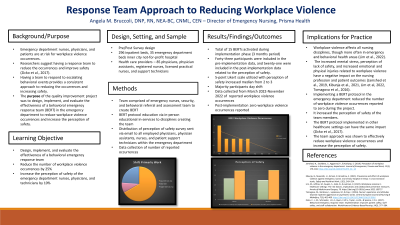Experience Hall
Response Team Approach to Reducing Workplace Violence

Has Audio

Angela M. Bruccoli, DNP, RN, NEA-BC, CNML, CEN (she/her/hers)
Director of Emergency Nursing
Prisma Health
COLUMBIA, South Carolina, United States
Aim: : Emergency department nurses, physicians, and patients are at risk for workplace violence occurrences. Researchers suggest having a response team to reduce the occurrences and improve safety1. Having a team to respond to escalating behavioral events provides a consistent approach to reducing the occurrences and increasing safety. The purpose of the quality improvement project was to design, implement, and evaluate the effectiveness of a behavioral emergency response team (BERT) in the emergency department to reduce workplace violence occurrences and increase the perception of safety. The purpose of the project was to design, implement, and evaluate the effectiveness of a behavioral emergency response team in the emergency department to reduce the number of workplace violence occurrences by 25% and increase the perception of safety of the emergency department nurses, physicians, and technicians by 10%.
Framework:: PDSA
Setting:: The quality improvement project was implemented in an inner-city not-for-profit hospital in central South Carolina. The hospital has 296 inpatient beds, 35 emergency department beds, and a locked five-bed unit for behavioral health patients. The emergency department is one of 10 within the 11 campuses in the healthcare company. Annual emergency department visits for fiscal year (FY) 2020 were 21,19112, FY2021 were 33,09013. There were 85 team members employed in the emergency department at the project site, including registered nurses, licensed practical nurses, patient support technicians, physicians, and physician assistants.
Stakeholder Team:: Nurse Director conducted the staff training, survey process, and data analysis. The CNO provided permission for a quality improvement project to be implemented. Security and Behavioral Assessment and Referral Team were part of the behavioral emergency response team created.
Methods: : A quality improvement design was utilized. The BERT protocol was created using evidenced-based protocols effective in reducing the number of workplace violence occurrences. Emergency nurses, patient support technicians, security, and behavioral assessment and referral team were trained in the BERT protocol. Workplace violence occurrences data were collected from March 2022 to November 2022. Post-BERT debriefs were conducted, and real-time education was provided after implementation. Survey data were collected to evaluate the perception of the safety of the emergency department team to evaluate the effectiveness of the BERT protocol.
Outcomes:: The number of workplace violence occurrences reported decreased 100% post-implementation BERT protocol. The perception of safety increased 36.5% post-implementation (2.1628 pre-implementation, 2.9524 post-implementation). Additionally, an increase in the awareness to report workplace violence occurrences resulted from education and implementation of BERT protocol.
Implications:: The forty-three participants pre-implementation and twenty-one participants post-implementation reported an increased perception of safety. Implementation of BERT was effective in reducing assaults against the emergency department team and increasing the perception of safety.

